 Simon Johansson has been playing off an on for 20 years and has only recently rediscovered his passion for the game. Now, he practices for close to 20 hours a week hoping that he can one day:
Simon Johansson has been playing off an on for 20 years and has only recently rediscovered his passion for the game. Now, he practices for close to 20 hours a week hoping that he can one day:
- become a scratch golfer.
- win at least local tournaments.
- turn pro.
Considering his ambitious goals I certainly have my work cut out for me.
I would describe Simon’s swing as being very deliberate. He has a nice setup and hits a lot of good positions but his swing plane definitely leaves some room for improvement.
Read on to see Simon’s swing and the fixes I’ve outlined for him.
The Swing
Simon’s swing can be seen here as a QuickTime movie. This shows the down-the-line angle with his driver. I would highly recommend that you watch the video, identify what you have found as his root problem, and then read on to see if you and I agree.
Swing Plane
Before really delving into the solution, let’s just quickly review what lines to draw when you are analyzing swing plane.
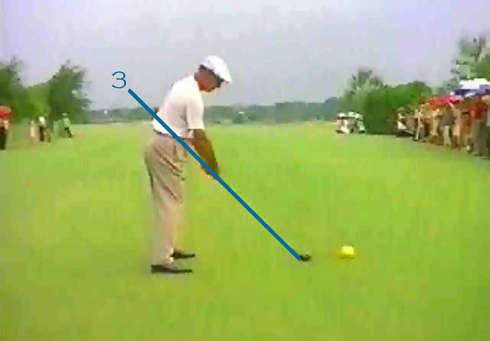
Line 3: Line 3 runs from the hosel of the club through the butt of the grip and continues up approximately two to three feet past your body. This line represents the absolute lowest that your club should ever go.
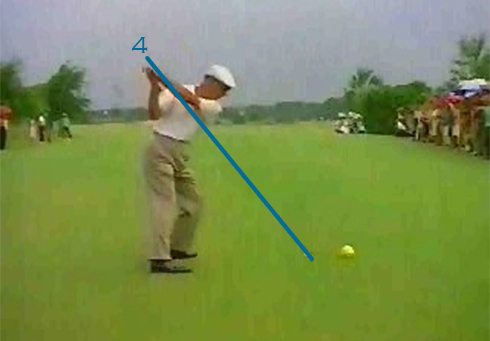
Line 4: Line 4 runs from the toe of your clubhead through your trailing shoulder. This represents the highest your hands, shaft and clubhead should go. If your leading hand is lower than this line, redraw the line so that it is touching the top of your hand. Remember, your hands, shaft, and clubhead should never cross this line during any point in your backswing or downswing.
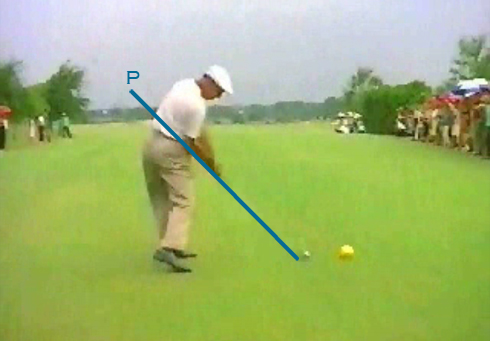
Line P: Line P is slightly more difficult to draw. This line is not drawn at the initial set up but should only be drawn at impact. To draw this line you will need to freeze the frame at impact and then draw a line running from the hosel of the golf club, through the butt of the grip, and continue approximately two to three feet outside of your body. With the proper swing plane you will come down this line and start your follow through on this line – which is being on plane.
Let’s take a few frames of Simon’s swing and see how he is doing with those lines drawn.
Take Away
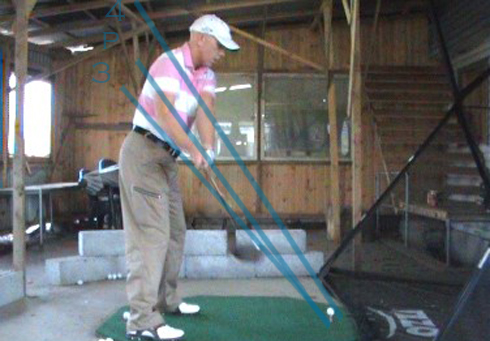
Top of Swing
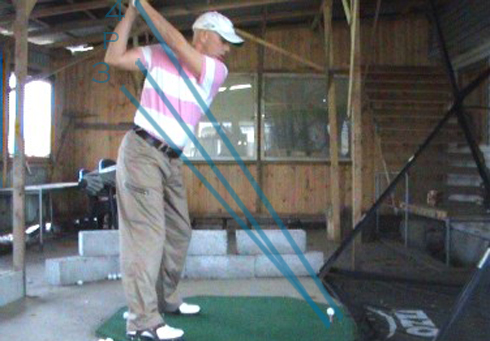
downswing
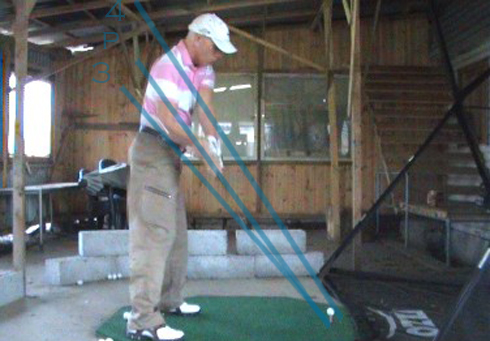
It may be hard to see but Simon does have one glaring error:
- His take away is a little low.
- His hands, arm, and shaft are crossing Line 4 at the top of his swing.
- He is under of Line P on his downswing.
Essentially, his hands are extremely high at the top of his swing but they drop so far that he actually gets off plane before he accelerates. Think Sergio Garcia but under… so think Sergio Garcia on Sunday at Augusta.
Crossing the Line at the Top
The solution to his problem is a bit different than Eddy in the previous entry. In fact, it is close to the exact opposite. Let me explain.
Once a player gets to the top of their swing the next few tenths of a second are crucial. If you have your hands high and then start to accelerate with your shoulders you are going to come over the top. If you have your hands low and then allow them to drop too far before you accelerate you are going to be under plane. The trick is finding a place where you can position your hands so that your drop and timing for your acceleration put you on plane. For each player, this could be completely different but there are some general rules that we can apply.
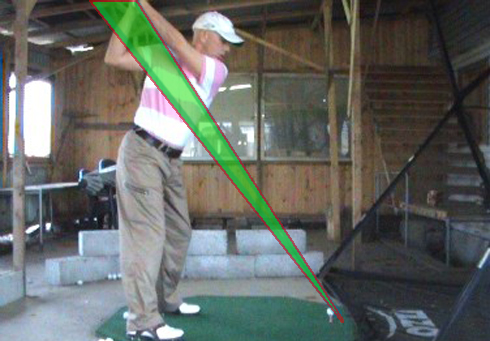
Line 4 Margin of Error
The first thing that we need to identify is what is too high and what is too low. As a general rule, the absolute highest that your hands should ever go is if you drew Line 4 from the outside of the golf ball through your trailing shoulder at set up. If you go higher than this, you are going to have to make such a long drop that you will commonly mis-time with your acceleration. On the other hand, the absolute lowest that your hands should ever go is the height of your shoulders at the top of your swing. If you go any lower than this, you are going to have to accelerate so early to stay on plane that you are going to actually lose quite a bit of power.
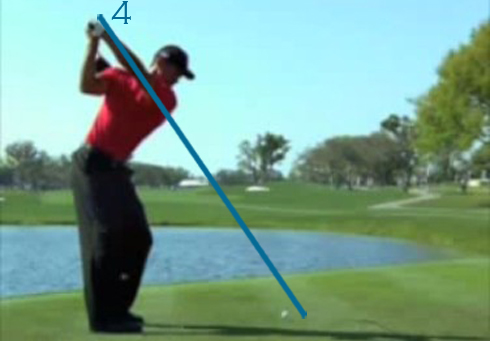
Hands High
Players that choose to have their hands higher at the top of their swing are choosing a very specific motion to get on plane. It should go something like this:
- Allow gravity to drop your hands and arms down to your shoulders while your hips are shifting forward,
- Begin to turn your hips as your hands approach the height of your pockets,
- Then once your hands reach the height of your pockets you accelerate through the ball with your shoulders, hips and arms until finish.
There are two very common problems that players that choose this type of swing experience. The most common problem is that rather than allowing gravity to drop their hands, they begin to accelerate with their shoulders. As a result, they go over the top hitting pulls, hooks, or slices. The other problem – which is the problem Simon is experiencing – is that a player may allow their hands to drop too far before they begin to accelerate. This results in a swing that is under plane.

Hands Low
Like players that choose to have their hands high at the top of their swing, players that choose to have their hands low have a very specific motion necessary to get on plane. It should go something like this:
- Allow gravity to drop your hands and arms down to your shoulders while your hips are shifting forward and turning,
- Then once your hands reach the height of your pockets you accelerate through the ball with your shoulders, hips and arms until finish.
There are two very common problems that players that choose this type of swing experience. The most common problem is when a player allows their hands to drop too far before accelerating causing them to be below plane. The other – less common – problem is that a player accelerates with their shoulders from the top of their swing with absolutely no drop causing them to be over the top.
Summary: Essentially, there is one difference that you must account for when choosing where you want to position your hands at the top of your swing: your shoulders. Both swings involve a slight drop of your hands from the top of the swing and both swings require you to being to accelerate once your hands reach the height of your pockets – or are a tangent to the arc. The difference is that you will feel like you are forced to accelerate almost directly out of the top of your swing with your hands lower and you will feel like you have to delay your shoulders if your hands are higher. Obviously, finding what is right for you can be tricky.
For Simon to get on plane, I believe he needs to make two changes. First, Simon needs to lower his hands so that he is at least below the Line 4 if it were drawn through his shoulder at set up. Second, I want Simon to feel as if he is turning his shoulders through the ball earlier than he currently is. My hope is that the combination of these two changes will put him on plane.
Potential Fixes
Lowering your hands is one of the easier fixes because there is an incredibly easy drill that will give you immediate feedback. I have heard it called a number of different things but for our purposes I’ll just refer to it as the clubhead cover drill. A video of this drill can be seen below or downloaded as an MPEG-4 (.mp4) movie here:
- Set Up:Set up to the ball as if you were going to hit a normal shot. After you have set up, place a clubhead cover between your trailing arm and your body.
- Backswing:During your backswing, ensure that the clubhead cover does not drop. If it does, your trailing arm is moving away from your body and is getting too high.
- Top of Swing:Again, the clubhead cover should not drop.
- downswing:During your downswing your trailing arm should never be moving away from your body. As a result, the clubhead cover still should not drop.
- Follow Through:During your extension your trailing arm will begin to move away from your body. Thus, the clubhead cover should come flying out and often will go straight down the target line.
Note that body type will determine just how high or low you need to position your clubhead cover. I would start with the cover in your armpit and then make adjustments by lowering it an inch or two if you are not getting the desired results.
Time Line: You will notice a change almost instantly both in feel and the technical aspects of your game. However, it may take a while to make this permanent in your swing. Use this with every single club you practice with in order to help make this change stick.
Be sure to monitor… timing of acceleration. Many players who are lowering their hands are so used to dropping their hands that they forget to accelerate a little earlier with their shoulders. Remember, your shoulders should not start to accelerate until your hands are a tangent to the arc – or basically at the height of your pockets.
Conclusion
Simon has a few other problems but his swing plane is clearly holding him back. To score low – especially under pressure – you have to have a swing that you can depend on. The difference between on plane and off plane can be the difference between say a Masters victory and hitting the ball to the left of the green during your first playoff hole. I look forward to seeing his results – even if he doesn’t win the Masters.
Your Turn!
If you’re interested in having your swing analyzed in a future edition of Swing Check here on The Sand Trap, check out the requirements page and submit your videos today!
IMO he is standing just a bit too upright with knees almost locked out. Also, he needs to shift his hips towards the target to initiate the downswing and drop the right shoulder and the club to the inside. At the moment it looks like he’s powering the swing with his arms
It appears to me that his entire swing is made from his arms and not his lower body. Look at hit hips at impact. They’ve barely turned toward the target. I don’t see how he gets any power.
Yeah, I see a super army swing with the wrists practically leading the hips. This looks FAR from the swing of someone who hopes to win local tourneys, much less go pro…
I think the main thing holding him back will be when the ball bounces off of something and hits him in the head (see video). Hit the ball into the net!
Nice swing. Here is
Looks like he is a little closed to his target line and that can cause him to be a little over the top at times. I would just adjust the set-up a little, get yourself more square to the line and maybe adjust posture (bend over from the hips slightly, and lower the hands) and a little more knee flex. he looks pretty tall. Check out Stewart Sinks posture…might be a good model for him…
You should be good to go….